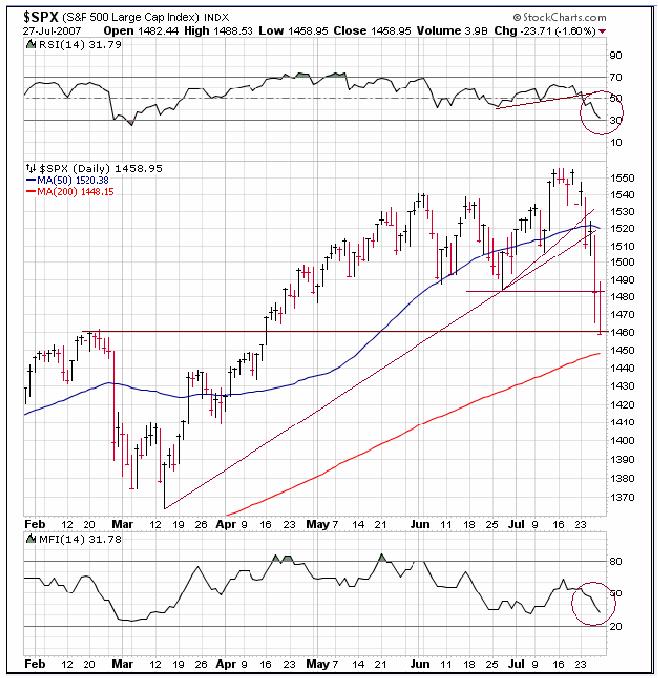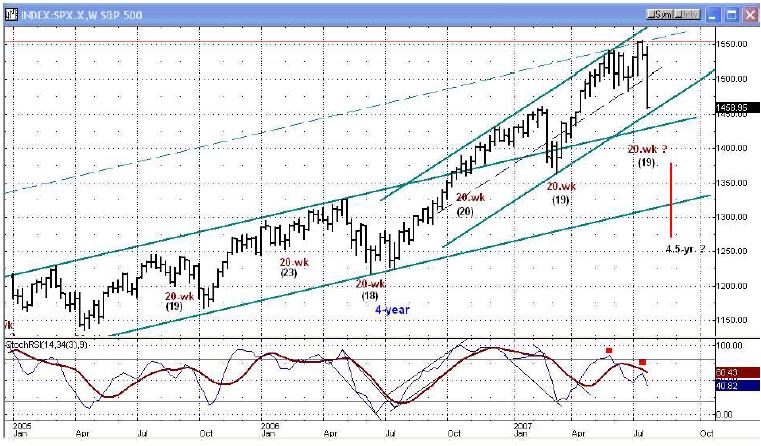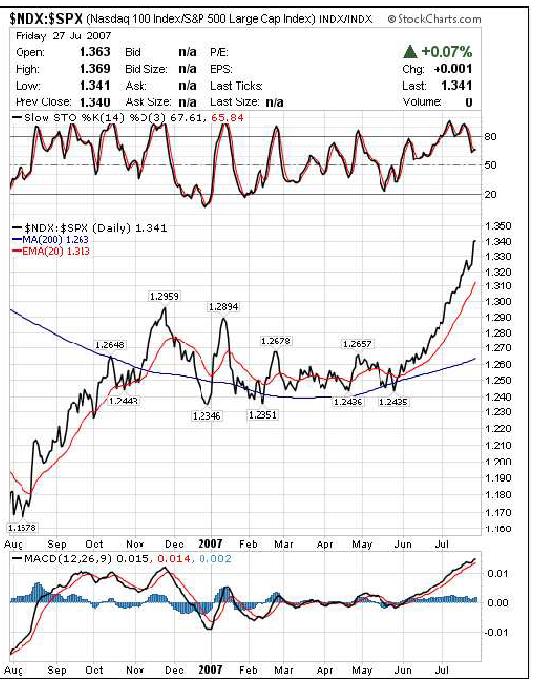Stock Market Cycle Turning Points Analysis 29th July 2007
Stock-Markets / Cycles Analysis Jul 29, 2007 - 04:39 PM GMTBy: Andre_Gratian
A 3-dimensional approach to technical analysis
Cycles - Breadth - Price projections
Current Position of the Market.
SPX: Long-Term Trend - The 12-year cycle is still in its up-phase but, as we approach its mid-point some of its dominant components are topping and could lead to a severe correction over the next few months.
SPX: Intermediate Trend - An intermediate trend is underway and is expected to continue for another few weeks.
Analysis of the short-term trend is done on a daily basis with the help of hourly charts. It is an important adjunct to the analysis of daily and weekly charts which determines the course of longer market trends.
Daily market analysis of the short term trend is reserved for subscribers. If you would like to sign up for a FREE 4-week trial period of daily comments, please let me know at ajg@cybertrails.com .
Overview
Two weeks ago, I wrote: The internals of the market are not terrific and unless it changes, this move may
be living on borrowed time.
And last week, in my last Week-end Report to subscribers: There are visible changes which are taking place in the intermediate-term trend…. Signs of a top are everywhere!
I had called for this week to be down sharply, but had not expected an 87-point drop in the SPX and a 700-point decline in the Dow! I think that the severity of the selling took many by surprise.
One index that had been persistently weaker than the others was the Russell 2000. And, of course,
the banking index! They were flashing warning signs along with deteriorating A/D figures. News
about the sub-prime problems (cited as the main reason for the market decline) had been around for
some time but were minimized, partially because the Fed chairman continued to assure investors
that the housing problem showed no sign of affecting the rest of the economy. All of a sudden the
psychology changed and perception that the era of easy credit may be over has increased. Could
this have anything to do with cycles?
What does this mean for the stock market? Are we at the beginning of a severe bear market?
Probably not. For now, let's just call this a good, long overdue intermediate-term correction which
has a few more weeks to go.
What’s Ahead?
Momentum:
The daily chart of the SPX (courtesy of StockCharts) shows graphically the sharpness of the decline.
The index has now broken an important trend line and former level, but it is approaching the
200-DMA which often acts as support for prices. Even more important, it has also reached the
February high, which should also provide temporary support.
The negative divergences to which I referred in the last newsletter are now much clearer with the benefit of hindsight. The RSI (top) and the Money Flow Index (bottom) failed to make new highs along with price, and when the RSI began to roll over and break its trend line, it signaled the start of the decline.
Both indicators are now in a downtrend and will need to stabilize before a reversal can take place. This will probably take more than a few days to accomplish, although a countertrend rally should be imminent.

On to the weekly chart! Last week's analysis stated: More negatives appear on this chart, with the index hitting the top of its channels. The two top channel lines intersect just about where the price closed this week. This should prove to be a very strong resistance level and is also an inflection point. This is what itlooks like now. Besides hitting the top of the channel, the SPX also had to contend with resistance at its 2000 top which it surpassed by a fraction, but could not get beyond. And the indicator at the bottom of the chart had a series of declining tops going back to February and was shouting caution.
Now, prices have retraced all the way to the bottom of the channel, another source of temporary support along with those shown on the daily chart.
Also, if this is the bottoming of the 20-week cycle it should bring about a good countertrend rally as it turns up, but notice that the bottom indicator is not yet oversold and that every important decline of the past has not reversed until it was.
I will discuss the cyclical forces behind this decline in the next segment.

Cycles
In the last newsletter, I mentioned that there were two separate cycle series affecting the market and
suggested that the 20-wk cycle may belong to one and the 4.5-yr to another. We are about to test
that theory because the immediate pressure behind the decline was not simply caused by the 9-wk
cycle, but was most likely the bottoming of the 20-week cycle which normally makes its low every 18-
20 weeks. Of course, it was assisted by the 4.5-yr cycle which is now in its down phase, and if the
latter were to make its low here, it should be reflected in the market action by an immediate
resumption of the uptrend. However, indicators suggest that the decline has further to go and is
more likely to reverse at a point which would coincide with the low of the larger cycle in September.
I need to repeat what I wrote last time because it is also pertinent to the current market action:
We must also keep in mind that one of the most dominant long term cycles, the 2-yr cycle, is in the process of topping and will start to bring downward pressure on the market between now and the end of the year.If the 2-yr cycle has already topped, it is beginning to add pressure to any other cycle which is in a down phase, So we may have 3 cycles currently pushing the market down and this may be why so much weakness developed so quickly.
Looking forward, the 20-wk cycle should have a limited effect on the market when it turns up but could generate a good rally and subsequently slow the descent for the rest of its term. After the 4.5-yr has bottomed, it is probable that the long-term uptrend will resume until the end of the year.
Projections
Last week, I had expected the SPX to decline to 1496-1501 by week's end. That target was
significantly exceeded, and the index has moved to another important projection level between 1456
and 1459 which is determined by combined Point & Figure and Fibonacci targets. Considering that
this level coincides with the February top which should provide important support, and that we are at
a cyclical low time-wise, it would not be surprising if the market should end its decline on Monday
and reverse course.
As far as the projection for the 4.5-yr low, the preliminary target is about 1440. This will be reexamined as we go forward and the market action produces a P&F pattern from which we can derive a confirming count.
Breadth
As a result of the recent weakness, the McClellan indicator is in a sharp downtrend and has reached
a level that it has not seen since the June-July 2006 lows. This indicates that more selling probably
lies ahead because the index will need time to steady itself and show a rising pattern with positive
divergence as the final low is made.
Naturally, the short-term indicator has had an effect on the summation index and sent it plummeting. It too will have to stabilize before we can have a market reversal.
Market Leaders & Sentiment
GE made a new bull market high as the SPX hit its peak, and the NDX went to a new high as well.
Both have retraced sharply in the decline, but the NDX, especially, shows strong relative strength to
the SPX, as the chart below (courtesy of StockCharts) shows. This is not the way that major tops are
made. Historically, both GE and the NDX are noticeably weaker than the large cap indices at the
end of a bull market. Therefore, it is fairly safe to assume that we are only in an intermediate
correction.

The sentiment indicators also do not show the degree of bearish reading required for a major top. The 50-DMA of the ISEE is not at a level associated with bull market highs, and the daily readings have been quite bullish for the past couple of days, suggesting a near-term reversal.
Summary
The SPX made an intermediate-trend peak at 1555 -- its former all-time high of 2000 -- and suffered
a severe decline last week. Various indicators, cyclic conditions, sentiment, and projections are
suggesting that it could have reached a temporary low and is ready for a good rally fueled by the 20-
week cycle, which is probably bottoming in this time frame.
Longer-term, the SPX is likely to extend its decline into September before it can reverse its intermediate downtrend.
The following are examples of unsolicited subscriber comments:
What is most impressive about your service is that you provide constant communication with your subscribers. I would highly recommend your service to traders. D.A.
Andre, You did it again! Like reading the book before watching the movie! B.F.
i would like to thank you so much for all your updates / newsletters. as i am mostly a short-term trader, your work has been so helpful to me as i know exactly when to get in and out of positions. i am so glad i decided to subscribe to turning points. that was one of the best things i did ! please rest assured i shall continue being with turning points for a long while to come. thanks once again ! D.P.
Andre, I must say that your service is fantastic, since I have signed up for your 30 day free trial I have made two successful trades. When my 30 day free trial is up please let me know so I can sign up as a regular member. I have tried a lot of services out there and I must say yours tops everything. Please use this testimonial if you like. S.W.
But don't take their word for it! Find out for yourself with a FREE 4-week trial. Send an email to ajg@cybertrails.com .
By Andre Gratian
MarketTurningPoints.com
If this information is of value to you, you should consider our trial subscription offer (above). Daily updates consist of a Morning Comment, Closing Comment (which occasionally includes an updated hourly chart of the SPX to illustrate the analysis), and at least one or more updates during the trading session whenever it is warranted by market action. These updates discuss phase completions, give projections, potential reversal points, and whatever else may be pertinent to the short-term trend.
“By the Law of Periodical Repetition, everything which has happened once must happen again, and again, and again -- and not capriciously, but at regular periods, and each thing in its own period, not another’s, and each obeying its own law … The same Nature which delights in periodical repetition in the sky is the Nature which orders the affairs of the earth. Let us not underrate the value of that hint.” -- Mark Twain
You may also want to visit the Market Turning Points website to familiarize yourself with my philosophy and strategy.www.marketurningpoints.com
Disclaimer - The above comments about the financial markets are based purely on what I consider to be sound technical analysis principles uncompromised by fundamental considerations. They represent my own opinion and are not meant to be construed as trading or investment advice, but are offered as an analytical point of view which might be of interest to those who follow stock market cycles and technical analysis.
Andre Gratian Archive |
© 2005-2022 http://www.MarketOracle.co.uk - The Market Oracle is a FREE Daily Financial Markets Analysis & Forecasting online publication.



